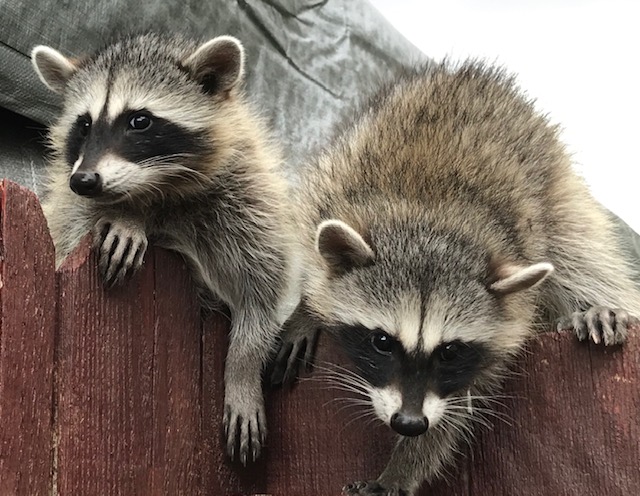 Gardening with Raccoons - August 12, 2020 Jeff Schalau, Agent, Agriculture & Natural Resources University of Arizona Cooperative Extension, Yavapai County Raccoons are common along Northern Arizona’s rivers, streams, irrigation ditches, and other locations where water and vegetation are present. In natural environments, they den in hollow trees, caves, rocky ledges, and other protected locations. Near human habitation, raccoons will den in chimneys, under houses, in abandoned structures, and woodpiles. Their opportunistic nature also draws them to urban environments. Once there, they can cause extensive damage to structures, crops, and landscapes. Adult raccoons may weigh from 10 to 30 pounds, are 2 to 3 feet in length, and are about 16 inches tall at the shoulder. Adult males occupy territories of 3 to 20 square miles, compared to 1 to 6 square miles for females. Raccoons do not hibernate but may sleep several days to a couple of weeks during extremely cold weather. They are nocturnal and solitary except when breeding or caring for their young. Breeding usually occurs between January and March, with females mating once a year. After a gestation period of 63 days, an average litter of 3 to 5 young are born. The young weigh about 2 ounces at birth, open their eyes at about 3 weeks, and are weaned from 2 to 4 months of age. Some young may disperse in late autumn, but all are driven away before the next litter is born. Raccoons will attack if cornered, especially if young are present. They typically are not long-lived in the wild. Fifty to seventy percent of all populations consist of populations under one year old. Raccoons are omnivorous and will eat plants or animals, depending on what is available. Preferred plant-based foods include fruit, vegetables (especially sweet corn) or nuts. Animal-based foods may include grubs, crickets, grasshoppers, crayfish, clams, frogs, worms, fish, turtles, bird eggs and nestlings, squirrels, rats, or mice. In urban and suburban environments, they will also eat dog or cat food, or garbage. Raccoons also kill chickens and other domestic fowl taking bites here and there, rarely consuming all they kill. Raccoon tracks are very distinctive with the front feet looking like small human handprints. Raccoons also use an established latrine area. I’ve spoken to several people over the years that asked why there were large piles of wildlife poop on their roofs or the back of unused sheds. Raccoons had likely established latrines in these situations. Raccoons carry several diseases that are transmissible to humans and domestic animals. Among these are rabies, distemper, mange, and canine and feline parvovirus. Raccoon feces may also contain Raccoon Roundworm (Baylisascaris procyonis) eggs. Humans coming into contact with feces that contain eggs can become infected. Clinical symptoms vary with the number of roundworm larvae present in the body and their location. If the larvae migrate to the eyes or brain, blindness or death may result. The best strategies to prevent raccoon damage are habitat modification and exclusion. Remove any food or water source, feed pets indoors, and secure garbage containers to prevent access. Restrict access to your roof by pruning trees away from eves and otherwise limiting access to the roof. Cover chimneys with hardware cloth or a metal cover when not in use. Keep poultry enclosed in a secure enclosure at night. Raccoons can climb almost any fence, but the addition of an electric wire strand (using a UL fence charger) at the top of the fence will likely discourage them. Electric fences alone can also be used with two strands: one at 6 inches and another at 12 inches above the ground. The wire strands cannot come into contact with adjacent plant material because the fence will be grounded and ineffective. Mowing with a line trimmer can minimize this. Raccoons will also dig under fences, so bury woven wire two feet below the soil surface where raccoon pressure is high. Raccoons are managed as game animals under state law in Arizona. For more information, consult with the Arizona Game and Fish Department (www.azgfd.com). Again, the best way to deal with backyard raccoon conflicts is to remove the attractants and/or exclude them from areas where they can do damage. With the exception of birds, you should never intentionally feed any wildlife species. Wild animals that are fed become habituated to human activity which alters their natural behavior. This almost always spells trouble for the wildlife and humans. See the online edition (URL below) for more information. You can follow the Backyard Gardener on Twitter – use the link on the BYG website. If you have other gardening questions, email the Master Gardener Help Desk in Prescott (prescottmg@gmail.com) or Camp Verde (verdevalleymg@gmail.com) and be sure to include your name, location, and phone number. Find past Backyard Gardener columns or provide feedback at the Backyard Gardener web site: https://cals.arizona.edu/yavapai/anr/hort/byg/. Images  Adult raccoon (Procyon lotor, photo by Alfred Viola, Northeastern University, Bugwood.org).
Adult raccoon (Procyon lotor, photo by Alfred Viola, Northeastern University, Bugwood.org). Juvenile raccoons in Prescott Valley, Arizona (Photo by Barbara McCurry, University of Arizona Master Gardener, Yavapai County).
Juvenile raccoons in Prescott Valley, Arizona (Photo by Barbara McCurry, University of Arizona Master Gardener, Yavapai County). Raccoon tracks (from: University of Wisconsin Extension).
Raccoon tracks (from: University of Wisconsin Extension).Additional Resources Raccoons, Utah State University Extension extension.usu.edu/wildlife-interactions/featured-animals/raccoons Raccoon Ecology and Damage Management, University of Wisconsin Extension wildlifedamage.uwex.edu/pdf/Raccoon.pdf |